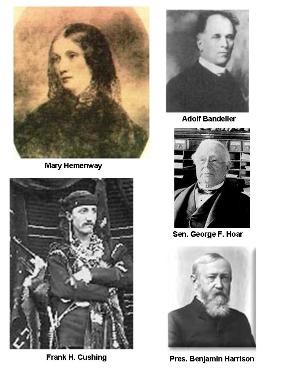
NPS A Brief History of the Casa Grande Ruins This is an artist's depiction of the Casa Grande ("Great House") and its surrounding compound as it may have appeared around 1350 C.E. One of the largest prehistoric structures ever built in North America, its purpose remains a mystery. Archeologists have discovered evidence that the ancestral Sonoran Desert people who built the Casa Grande also developed wide-scale irrigation farming and extensive trade connections which lasted over a thousand years until about 1450 C.E. Archeologists call a site where there are earthen buildings, red on buff pottery, and extensive canals "Hohokam" but this is not the name of a tribe or a people. Years of misunderstanding have confused the ancestors of the O'Odham, Hopi, and Zuni people with the name Hohokam, which is not a word in any of their languages nor the name of a separate people. 
The Casa Grande was no longer used around 1450 C.E. Since the ancestral Sonoran Desert people who built it left no written language behind, written historic accounts of the Casa Grande begin with the journal entries of Padre Eusebio Francisco Kino when he visited the ruins in 1694. In his description of the large ancient structure before him, he wrote the words "casa grande" (or "great house") which are still used today. More became known about the ruins with the later visits of Lt. Col. Juan Bautista de Anza's expedition in 1775 and Brig. Gen. Stephen Watts Kearny's military detachment in 1846. Subsequent articles written about the Casa Grande increased public interest. During the 1860's through the 1880's more people began to visit the ruins with the arrival of a railroad line twenty miles to the west and a connecting stagecoach route that ran right by the Casa Grande. The resulting damage from souvenir hunting, graffiti and outright vandalism raised serious concerns about the preservation of the Casa Grande. 
Anthropologist and historian Adolph Bandelier visited the Casa Grande ruins in 1883-1884 and reported on its condition and probable significance. The Hemenway Southwestern Archaeological Expedition of 1887-1888, sponsored by Massachusetts philanthropist Mary Hemenway and led by anthropologist Frank H. Cushing, produced further information on the deterioration of the Casa Grande. As a result, several influential Bostonians urged Massachusetts Senator George F. Hoar to present a petition before the U. S. Senate in 1889 requesting that the government take steps to repair and protect the ruins. Repair work began the following year, and in 1892, President Benjamin Harrison set aside one square mile of Arizona Territory surrounding the Casa Grande Ruins as the first prehistoric and cultural reserve established in the United States. 
The General Land Office took over management of the ruins and hired a young man named Frank Pinkley in 1901 to be the first on-site custodian. In 1903 a shelter roof of corrugated iron supported by redwood timbers was built over the Casa Grande, and between 1906 and 1908 major excavations and repairs of the ruins were conducted under the direction of Jesse Fewkes of the Bureau of Ethnology. Most of the lower walls visible today were uncovered at that time. President Woodrow Wilson proclaimed Casa Grande Ruins to be a National Monument on August 3, 1918 and management of the Ruins was transferred to the National Park Service. Frank Pinkley stayed on as custodian and eventually became the superintendent of all southwest monuments. Part of his promotion effort was to produce a wide range of literature about Casa Grande Ruins and to host the annual Arizona Pageant from 1926 to 1930. _281x374.jpg?maxwidth=650&autorotate=false)
Several important construction projects were undertaken during the 1930's. The main part of the visitor center building with adjacent parking lot and entrance road, and a new steel shelter roof over the Casa Grande, were completed in 1932. Between 1937 and 1940, the Civilian Conservation Corps constructed a number of adobe buildings to support park operations. All of these structures remain in use today and are now listed on the National Register of Historic Places. As a result, the general physical appearance of Casa Grande Ruins has changed very little since the 1940's.
Continuing research, ruins repairs, interpretive programs, and visitor center remodeling are all part of the continuing effort to provide the best visitor experience possible, and to fulfill the National Park Service's mission to protect, preserve and make available for present and future generations the many wonders of Casa Grande Ruins National Monument.
|
Last updated: December 22, 2020
